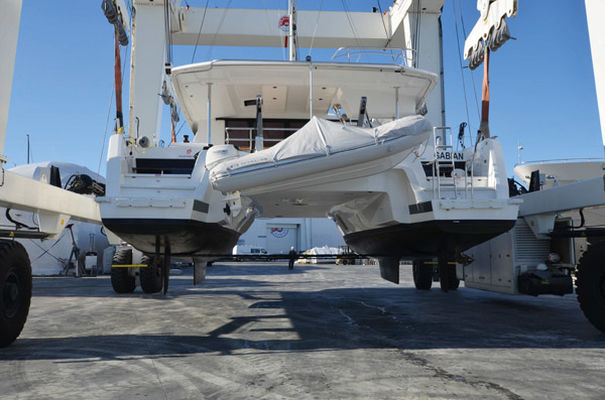
Issue #: 183
Published: May / June 2022
- Price per issue - digital : 6.50€Digital magazine
- Price per issue - print : 9.50€Print magazine
- Access to Multihulls World digital archives Digital archives
Saildrive legs warrant as much attention as the engines themselves. The minimal maintenance is very easy to do when you’re hauled out for bottom paint. Sometimes, saildrives can incur damage and you may need to do a little more than a simple oil change.
Here’s the procedure in pictures.
Saildrives are becoming more and more common on our multihulls: they allow for saving precious space by moving the engines as far aft as possible and by eliminating the propellor shaft. The saildrives are mechanical parts in motion: their drive shafts, composed of two angular gearboxes to transmit the engine’s power to the propeller, can wear out quickly if they are not maintained. They require attention, especially since they are immersed in seawater and sometimes subjected to high stresses. Manufacturers recommend changing the oil every 400 hours or once a year. O-rings, shaft seals and the main rubber boot should be changed every seven years. While the oil change is an easy operation to perform at haulout time, it is not the same if the O-rings and shaft seals are defective following any sort of propeller incident. The well-known line round the prop doesn’t just happen to others and the unfortunate consequences are not always visible at first sight. The suddenly blocked propeller applies a torsion to these joints which then let the sea water pass into the mechanism of the base making the lubricating oil inoperative. A visual check of the oil can be done with the dipstick on the top of the saildrive unit. But we don’t necessarily think about that - as is the case on the charter catamaran which served as an example for this report, it is sometimes only when we change the oil that we notice the problem. Because without lubrication, there’s a risk of breaking the saildrive... The only solution is to dismantle the hub of the saildrive to change the two O-rings and the shaft seal. The operation requires you to have all the tools on board, plus a section of pipe the size of the shaft seal that you should have aboard if on long trips.

The annual haulout for antifouling, etc is the ideal time to change the oil in your saildrive legs. Just before hauling out, run the motors in gear for about ten minutes so that the oil heats up and becomes more liquid and so will drain easier.

1) The part of the saildrive inside the boat is located at the back of the motors. Unscrew the plug: this one features a graduated scale which acts as a dipstick for oil level. This dipstick allows a visual check of the condition of the oil.

2) An initial visual check will allow you to detect potential problems. The first thing to check is the wear level of the anodes, which may need to be replaced, and the condition of the propeller blades – saildrives do not appreciate vibration.

3) The draining itself requires only very basic tools - a flat screwdriver and a hammer should suffice..

4) Here, the screw head of the bung was clogged with growth. Philippe, the Tendance Voile technician, used a small hammer, and the job was done.

5) We placed a small bucket beneath the leg to drain the oil into. Here, the oil has a normal aspect: it is all good, all we need do now is refit the bung and to pour fresh oil back in from inside the boat.
What readers think
Post a comment
No comments to show.